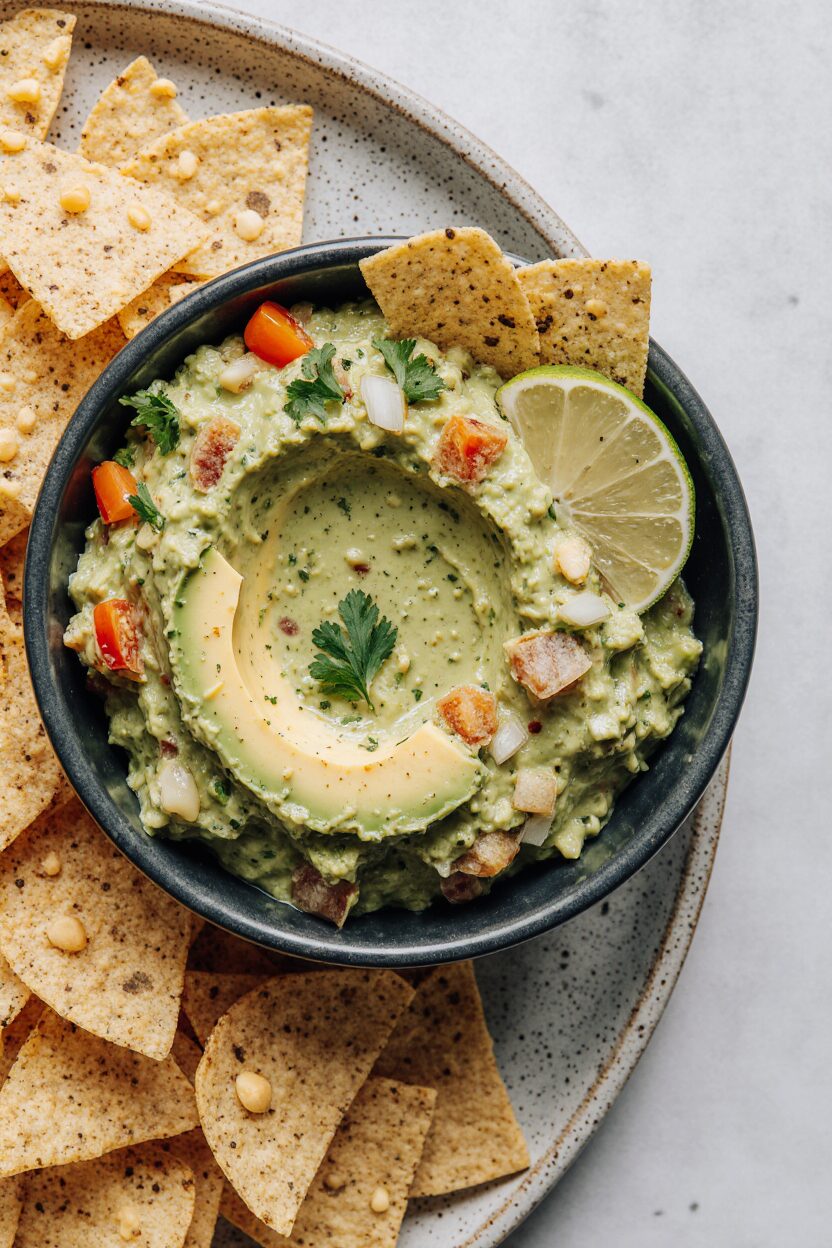The beauty of this guacamole lies in its simplicity. With just a handful of fresh ingredients, you can create a creamy, zesty dip that perfectly balances richness and brightness. The jalapeño adds a subtle heat, while the lime juice and cilantro brighten up every bite.
This recipe is adapted from the iconic Rosa Mexicano restaurant and was designed to be made tableside — interactive, quick, and always crowd-pleasing. Whether you’re hosting a party, prepping for Taco Tuesday, or simply need a snack fix, this guacamole delivers big flavor in no time.
Full Recipe:
-
2 ripe Hass avocados
-
1 ½ tablespoons finely chopped white onion
-
1 tablespoon minced fresh jalapeño (with seeds for heat)
-
1 ½ tablespoons finely chopped fresh tomato (optional)
-
1 tablespoon chopped fresh cilantro
-
1 tablespoon fresh lime juice (or to taste)
-
Salt to taste
-
Tortilla chips, for serving
Directions:
-
Cut the avocados in half, remove the pits, and scoop the flesh into a medium bowl.
-
Use a fork or potato masher to gently mash the avocado until chunky-smooth.
-
Stir in the white onion, jalapeño, tomato (if using), cilantro, and lime juice.
-
Season with salt to taste. Mix gently until combined.
-
Serve immediately with tortilla chips.
Prep Time: 5 minutes | Cooking Time: 10 minutes | Total Time: 15 minutes
Kcal: ~150 kcal per serving | Servings: 4
History and Origin
The word “guacamole” comes from the Nahuatl (Aztec) word “āhuacamolli”, which translates to “avocado sauce.” This simple but flavorful dip dates back to the Aztec Empire in what is now Mexico. Avocados were revered by the ancient Mesoamerican peoples—not only for their taste but for their nutrient density and supposed aphrodisiac qualities.
When Spanish conquistadors arrived in the 16th century, they quickly adopted the dish, and guacamole began its journey into broader Latin American and eventually global cuisine. Over the centuries, guacamole evolved alongside shifting culinary trends but remained firmly rooted in Mexican tradition.
The dish rose in popularity in the United States particularly in the late 20th century, fueled by a growing interest in Mexican and Tex-Mex cuisines. The rise of avocado imports from Mexico, particularly after the lifting of trade restrictions in the 1990s, also made avocados more accessible year-round, turning guacamole from a rare treat into a household favorite.
Today, guacamole is not only a party essential but a cultural ambassador, representing the fresh, bold, and flavorful essence of Mexican cooking.
Variations and Adaptations
While traditional guacamole consists of just a few core ingredients—avocado, lime, onion, chili, and cilantro—the beauty of this dish lies in its adaptability. Every region in Mexico (and beyond) has its own take on guacamole, and there are countless ways to tweak the recipe based on personal taste, available ingredients, or dietary needs.
Regional Variations:
In central Mexico, tomatoes are often added for a bit of acidity and color. In Yucatán, you might find orange juice instead of lime, or even some tropical fruits like mango or pineapple added for a sweet contrast. Some regions include serrano peppers instead of jalapeños, or even roasted garlic for deeper flavor.
Modern Twists:
In the U.S. and other parts of the world, guacamole has been reimagined in countless ways:
-
Bacon guacamole adds a smoky, savory note.
-
Greek guacamole swaps cilantro for parsley and adds feta cheese.
-
Vegan guac with nutritional yeast offers an umami kick without any animal products.
-
Guacamole with peas or edamame blends in extra greens for a lower-fat option.
-
Spicy chipotle guac includes smoky adobo sauce for an extra kick.
No matter the variation, the key is to maintain that creamy base while playing with flavors that complement the avocado.
Nutritional Information
Avocados, the star ingredient in guacamole, are packed with nutrients and healthy fats, making this dish both indulgent and nutritious. Here’s a breakdown of the typical nutritional profile for a ¼ cup (about 60g) serving of guacamole:
-
Calories: ~150 kcal
-
Fat: 13–15g (mostly monounsaturated fat from avocado)
-
Carbohydrates: 8g
-
Fiber: 5g
-
Protein: 2g
-
Sugars: 1g
Micronutrients include:
-
Potassium: Avocados contain more potassium than bananas!
-
Vitamin K, E, C, and several B-vitamins
-
Folate: Supports brain and cellular health
-
Magnesium and Copper: Important for bone and heart health
Despite being calorie-dense due to its fat content, guacamole is incredibly filling, meaning you’re less likely to overeat when it’s part of a balanced meal.
Serving Suggestions and Pairings
Guacamole may have originated as a humble dip, but it’s now a culinary chameleon that enhances all sorts of dishes. Here are a few ways to elevate your meals with guacamole:
Classic Pairings:
-
Tortilla chips – the undisputed pairing, salty and crunchy against the creamy dip.
-
Tacos, burritos, enchiladas – a dollop of guac adds freshness and cools down spicy flavors.
-
Nachos – spoon some guac on top of cheesy nachos for extra indulgence.
Creative Ideas:
-
Avocado toast – level up your breakfast by adding guacamole instead of plain avocado.
-
Burgers and sandwiches – a smear of guac adds creaminess and healthy fats.
-
Grilled proteins – serve guacamole alongside grilled chicken, steak, or shrimp as a vibrant sauce.
-
Stuffed sweet potatoes – spoon guacamole into roasted sweet potatoes for a hearty vegetarian meal.
Drink Pairings:
-
Margaritas (classic or spicy)
-
Mexican lager or a light IPA
-
Cucumber lime agua fresca for a refreshing non-alcoholic option
Tips and Tricks for Success
Although guacamole is simple to make, a few expert tips can take yours from good to unforgettable:
-
Use ripe avocados – they should yield slightly to gentle pressure. Overripe avocados will taste bitter and be too mushy.
-
Mash by hand – avoid blenders or food processors. A fork or molcajete (traditional mortar and pestle) gives the best texture.
-
Add lime juice immediately – it enhances flavor and slows oxidation, keeping your guac greener longer.
-
Season with salt thoughtfully – a little goes a long way, and salt enhances the natural richness of avocado.
-
Serve fresh – guacamole is best eaten within a few hours of making. If you need to store it, press plastic wrap directly onto the surface to minimize air exposure.
Potential Health Benefits
Guacamole isn’t just tasty—it’s a nutritional powerhouse. Thanks to its high content of monounsaturated fats, guacamole supports heart health by helping lower bad cholesterol (LDL) and increasing good cholesterol (HDL).
The fiber in avocados aids digestion and helps maintain stable blood sugar levels. Combined with lime juice, onions, and cilantro—all of which offer antioxidant properties—guacamole becomes a dish that not only delights your taste buds but also nourishes your body.
Jalapeños provide a boost of capsaicin, a compound known to stimulate metabolism and reduce inflammation. The tomatoes (if included) add lycopene, a powerful antioxidant linked to lower risks of certain chronic diseases.
When eaten in moderation, guacamole can be part of a balanced, anti-inflammatory diet, promoting satiety and supporting a healthy gut.
Conclusion
Guacamole is far more than just a party dip—it’s a dish rich in history, full of flavor, and bursting with health benefits. Whether you stick to the traditional recipe or venture into creative variations, this creamy green spread will never disappoint.
Next time you’re looking for something quick, flavorful, and wholesome to serve, whip up a batch of guacamole. You’ll impress your guests, nourish your body, and pay homage to a dish with ancient roots and timeless appeal.
Give it a try, and don’t be afraid to make it your own! 🥑💚





